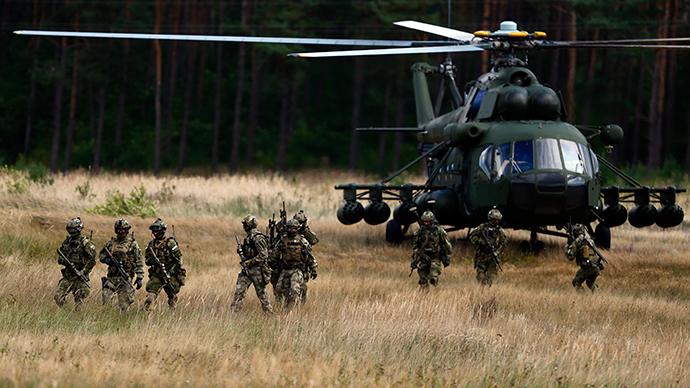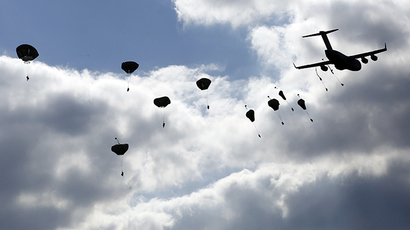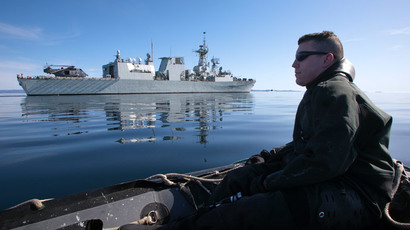New NATO chief reassures Poland amidst Ukraine crisis

NATO’s new secretary-general has stated that its rapid reaction force can be deployed whenever necessary in an interview on Polish television aimed at reassuring eastern bloc countries that they have support in the aftermath of crisis in Ukraine.
[EDITOR'S NOTE: A previous version of this article quoted new NATO Secretary-General Jens Stoltenberg as saying that NATO could deploy “wherever it wants”. The quote came from a report by Reuters news agency. However, the Polish broadcaster TVP Info’s website, who owns the interview, does not have this quote in their transcript.]
New NATO Secretary-General Jens Stoltenberg has paid a visit to NATO member Poland, where he reiterated calls for a rapid reaction “spearhead” force that could launch a military offensive within days.
READ MORE: US tanks arrive in Baltics, Poland requests greater US military presence
"Next year, at the ministerial meeting, we will take decisions regarding the so-called spearhead but, even before it is established” Stoltenberg told state-owned Polish broadcaster TVP Info. "NATO after all, has a powerful army and we can deploy it," he said.
In September, his predecessor Anders Fogh Rasmussen outlined the specifics of the rapid reaction force as comprising “several thousand troops, ready to respond where needed with air, sea and special-forces support.”
Amid talk of a “spearhead” NATO force, the United States last month transferred 20 M1A1 Abrams main battle tanks and about 700 soldiers, along with Bradley and Stryker armored vehicles, to the Baltic States, marking the first time the US has shipped armored vehicles to Europe since the end of the Cold War, Reuters noted.
Such a military force was intended to substitute for permanent NATO bases in Eastern Europe, which the Western military organization pledged not to create following the collapse of the Soviet Union.

Although some member states, like Poland and Latvia, recently
advocated on behalf of a permanent NATO presence on their
territory, more influential members like Germany rejected the
idea on the ground that it could provoke a strong reaction from
Russia.
Indeed, much of the current hysteria over Ukraine has been
generated by reports in the Western media that blamed ‘Russian
aggression’ for the events in Ukraine, even as no credible
evidence to support such serious claims have been forthcoming.
Yet it has been Western political figures – like former US
Senator John McCain and Assistant Secretary of State Victoria
Nuland - who were regularly seen in the capital, Kiev, as the
crisis was simmering.
Nevertheless, Stoltenberg, a former Norwegian prime minister,
appears to be taking a more aggressive approach to NATO
expansion, telling his Polish interviewer, “We can deploy it
wherever we want to."
According to the military bloc's chief, NATO should be able to
have both an expanding NATO force and good relations with Russia.
"There is no contradiction between a strong NATO and building
constructive relations with Russia," Stoltenberg, who began
his new assignment last week, told the Gazeta Wyborcza daily, as
cited by Reuters.
Such comments will certainly raise eyebrows in Moscow, which has watched from the
sidelines as NATO has continued a relentless eastward sprawl
towards its borders since 1990. This has occurred despite a
verbal pact formed between US and Russia that the Western
military organization would not move towards Russia’s borders.

Spiegel magazine concluded in 2009, following the release of
historical documents relating to the event, that “there was
no doubt that the West did everything it could to give the
Soviets the impression that NATO membership was out of the
question for countries like Poland, Hungary or
Czechoslovakia.”
On February 10, 1990, Hans-Dietrich Genscher, the German foreign
minister, told then-Soviet leader Mikhail Gorbachev's former
foreign minister, Eduard Shevardnadze, in a recorded telephone
conversation, "We are aware that NATO membership for a
unified Germany raises complicated questions. For us, however,
one thing is certain: NATO will not expand to the east."
One day earlier, in St. Catherine’s Hall at the Kremlin, then-US
Secretary of State James Baker made a pledge to Gorbachev that if
the Soviets granted the reunification of Germany, NATO would not
move “one inch” further east.
Finally, Jack Matlock, the US ambassador to Russia at the time,
has gone on record as stating that Moscow was given a "clear
commitment" with regards to NATO’s pledge not to expand
further in Russia’s direction.
Since 1990, NATO has added 13 new member states to its ranks,
bringing the organization to 28 members – and increasingly closer
to Russia’s doorstep.
Meanwhile, even the idea of Russia-NATO cooperation on the US
missile defense shield for Eastern Europe has been denied to
Moscow, which has warned on numerous occasions in the past of a
“new arms race” unless some sort of a mutual agreement
is found.














